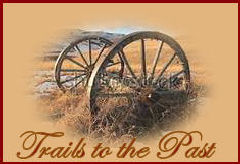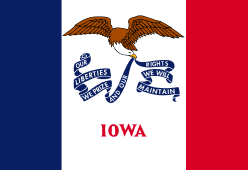We have in previous chapters given
particulars of the early settlement of this
county, a sketch and history of the Winnebago
Indians who (after the Sues and Foxes who formerly
occupied a large part of Iowa, and were removed by
treaty, as will be seen from state history,)
occupied this territory just previous to the
coming of the whites, their traits and
characteristics and intercourse between the two
races; also a sketch of pioneer life here, and the
incidents in the early settlement of the county.
We continue the history of the county by first
giving a brief resume of leading
events.
The erection of the fort for the
military supervision of the Indians, overlooking
the site of the village which now bears its
name-Fort Atkinson-was commenced on the 2d of
June, 1840.
Capt. Sumner, afterward, the renowned Gen.
Sumner, being in command. He remained in charge
till 1846, when he left to join the U. S. forces
in the Mexican War.
After the removal of the Indians, in
1848, the military appearance of the fort was no
longer kept up but it was not entirely abandoned
as a post, until some years later.
It was in the spring of 1842 that
Rev. D. Lowery, who had just been appointed an
Indian agent, commenced the erection of the
mission buildings at Old Mission about five miles
southeast of Fort Atkinson, and in 1843, Col.
Thomas, his assistant, built the first grist mill
in Winneshiek County. The first permanent
settlement in that vicinity commenced in 1847,
when those pioneers and homesteaders, Gotlob and
Gotleib Krumm, Charles Kregg, and Francis Rogers
arrived at Fort Atkinson in June, Gotloo Krumm
coming directly from Germany. Gotlob his wife and
two children had for their first habitation a
deserted Indian wigwam near a beautiful spring. In
a few weeks a log house was built for them in the
same locality, being the first actual settlers'
cabin in that part of the
county.
A. R. Young, who was a soldier in
the fort, would be entitled to the honor of being
the first settler as he remained and settled after
the garrison left, if the time of his coming to
the fort could be
counted.
Mr. Joel Post, referred to in a
previous chapter, was the first actual settler in
the reservation. But as his log house, built in
1841, was on the site where Postville now stands,
it is outside of the county line, and therefore he
cannot be called the first settler in Winneshiek
County.
Some authorities say that the Fort
Atkinson settlers, named above, did not come until
1848, and that Hamilton Campbell and his wife, who
made a claim June 7, 1848, in Bloomfield Township,
were the first permanent settlers. The names of
the old settlers as they successively arrived,
have been given in a previous chanter to which our
readers are referred for further detail; and we
close this resume of that portion of the history
by recalling a few points of
interest.
The honor of being the first white
child born in the county belongs to Mary Jane,
daughter of Mr. Jas. Tapper, one of the mechanics
who built Fort Atkinson, where she was born on the
16th of January, 1841; she married Robert M. Boyce
and lives near
Monona.
The first church in the county,
except the old Missionary Chapel was a Catholic
edifice, erected near Twin Springs. The first
public school building was built at the corner of
Decorah, Springfield and Glenwood Townships, in
1852.
The location of the first post office has
in previous records been given to Jamestown,
Frankville Township, in 1851. But there were post
offices at Fort Atkinson and Old Mission before
that time, as is noted
elsewhere.
The first marriage recorded was that
of Johannes Evenson to Catherine Helen Anderson,
in October 1851, Rev. N. Brandt performing the
ceremony.
"The first death to occur in the
county was that of a Government teamster named
Howard. He was engaged in the transportation of
material from Fort Crawford to Fort Atkinson, to
be used in the construction of the latter. On the
8d of October, 1840, a heavy snow had fallen, and
on the next day Mr. Howard started from Joel
Post's place, or Postville, to go to Fort
Atkinson. A party following in his wake the next
day were surprised to find his loaded wagon in the
road and team and driver gone. They
followed his track up to near the present site of
Castalia, where they found him frozen stiff in
death. The same day his remains were brought to
the Fort, and on the next day, or 5th of October,
1840, he was buried.
The first newspaper was the Decorah
Chronicle, published in 1856. With this
hasty rehearsal of leading events, most of them
re-corded more fully in other chapters, we take up
the county history where it was left in the first
chapter; we are now approaching an interesting
period, embracing the organization of the county
and the successive strife for securing the county
seat which was finally and permanently located at
Decorah.
To the Day family belongs the unquestioned
honor of being the first settlers in Decorah; and
as this became the county capitol and has grown to
be the most important and influential town, it
naturally gives them pre-eminence over other
settlers-especially as it is to members of that
family to a large extent, that the credit is due
of securing the county seat for Decorah as well as
the Land Office soon afterward. The Days came to
Decorah on the 10th of June, 1849. The family
consisted of nine persons, William and Elizabeth
Day, Mrs. Day still living, and their sons
Claibourne F. Day, Richard V. Day, and John F.
Day, being from that time until now prominent and
influential citizens.
Another early settler who was a prominent
factor in deciding the county seat contest, was
the late ex-Judge David Reed, whose family settled
in the northeast quarter of section 25, in
Bloomfield township, in August, 1848. Mr. Reed was
born in 1799, was elected County Judge at the age
of 52, and held that office from 1851 to 1855.



